-
 A charming collection of myths, legends and tales with giants, magic, saints, robust friars, Robin Hood and miracles.
A charming collection of myths, legends and tales with giants, magic, saints, robust friars, Robin Hood and miracles. -
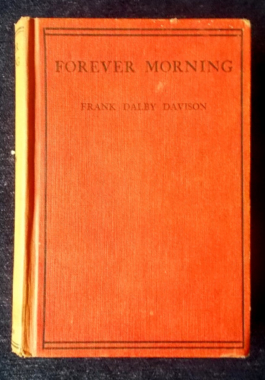 The principal characters in the story are Doris Brunton and Andy with other characters existing mainly for contrast. There is no sickly sentimentalism, the love and romance being concerned with the hero's battle against harsh reality. Set in the sheep country of New South Wales and Queensland with distinctive characterisations and the eternal atmosphere of the Australian bush.
The principal characters in the story are Doris Brunton and Andy with other characters existing mainly for contrast. There is no sickly sentimentalism, the love and romance being concerned with the hero's battle against harsh reality. Set in the sheep country of New South Wales and Queensland with distinctive characterisations and the eternal atmosphere of the Australian bush. -
 The Fowler Vacola Jar method of preserving fruit and vegetables out of season was world famous and it looks to be coming back into fashion as more and more people grow their own food. Contains very detailed instructions and is a must for those wishing to live the alternative, slower-paced lifestyle.
The Fowler Vacola Jar method of preserving fruit and vegetables out of season was world famous and it looks to be coming back into fashion as more and more people grow their own food. Contains very detailed instructions and is a must for those wishing to live the alternative, slower-paced lifestyle. -
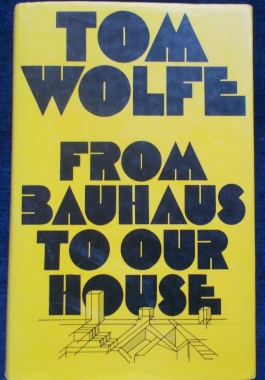
The irrepressible Wolfe has a satiric 'go' at the pretensions of Bauhaus art, attitudes and architecture. 'Starting from zero', 'bourgeois', the Cubists, Fauvists, Secessionists and every 'ism' comes under the gun, including Post-Modernism. Wolfe follows architectural design from Europe to America where Bauhaus was embraced in earnest and explores, with due irony, the vast contradiction between the bare, spare impersonal and abstract Bauhaus architecture and the exuberant, muscle-flexing populace that it serves. Illustrated with black and white photos
-

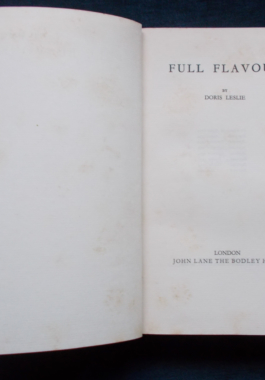
Full Flavour: Doris Leslie
$25.00Catherine DuCrox, at the age of eighteen, abruptly inherited her father's RUN-DOWN cigar and tobacco shop. For a young woman in Victoria's England to take it upon herself to become a business owner was almost scandalous - and in such a masculine-oriented business as well. Yet she goes ahead to first create an income for her mother and sister and later to extend her empire, becoming the first tobacconist to import Indian cigars and the first to introduce cigarettes to the public. Along the way, she finds that breaking the rules will not always get her what she wants - and that some rules are never meant to be broken. -
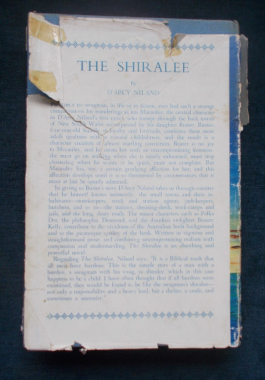
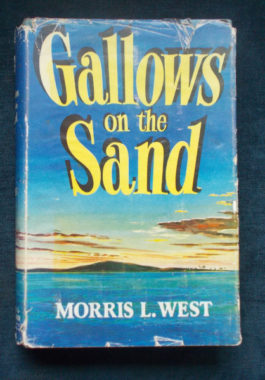 A rare first edition of West's second book, with the ingredients for first class entertainment: a disillusioned hero who seeks escape in treasure hunting, a sunken galleon, a lonely tropical island, a thoroughly modern villain and a very beautiful girl. The background is authentic, research by West when he travelled the length of the Great Barrier Reef in the tracks of the early navigators.
A rare first edition of West's second book, with the ingredients for first class entertainment: a disillusioned hero who seeks escape in treasure hunting, a sunken galleon, a lonely tropical island, a thoroughly modern villain and a very beautiful girl. The background is authentic, research by West when he travelled the length of the Great Barrier Reef in the tracks of the early navigators. -
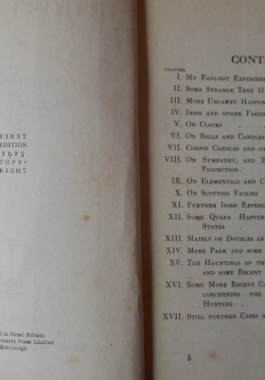
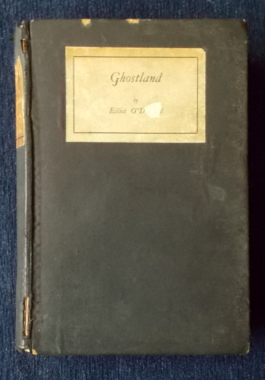
Ghostland: Elliot O’Donnell
$90.00Britain's most famous ghost hunter tells of his childhood experiences and encounters with ghosts , as well as touching on a wealth of other paranormal events: corpse candles, elementals, curses, doubles or 'doppelgangers', the hauntings of the Thames Embankment and much more from his vast store of personal experience. -
 A treasure-trove of picture-stories and written stories, in colour and black and white. There's mysteries and secrets, heroic adventures and holidays, school stories and quizzes for pre- and early teen girls.
A treasure-trove of picture-stories and written stories, in colour and black and white. There's mysteries and secrets, heroic adventures and holidays, school stories and quizzes for pre- and early teen girls. -
 Being an Imagined Sequel to A Christmas Carol. Seven years after Scrooge was converted - to everyone's satisfaction - we see that Bob Cratchit has done well as the smug senior partner of Cratchit and Scrooge; Tiny Tim, cured of his ailment, is now a troublesome teenager; his sister Belinda, the remaining unmarried daughter of the household falls unsuitably in love; and Scrooge has given away most of his money, is crippled with gout and can't get upstairs, and so lives in the small cloakroom behind the Cratchit's front door. Cratchit, informed of his impending knighthood, tries to have Scrooge sent away - and now it's Bob who must learn a lesson in charity! Illustrated by Mark Summers.
Being an Imagined Sequel to A Christmas Carol. Seven years after Scrooge was converted - to everyone's satisfaction - we see that Bob Cratchit has done well as the smug senior partner of Cratchit and Scrooge; Tiny Tim, cured of his ailment, is now a troublesome teenager; his sister Belinda, the remaining unmarried daughter of the household falls unsuitably in love; and Scrooge has given away most of his money, is crippled with gout and can't get upstairs, and so lives in the small cloakroom behind the Cratchit's front door. Cratchit, informed of his impending knighthood, tries to have Scrooge sent away - and now it's Bob who must learn a lesson in charity! Illustrated by Mark Summers. -
 The story of the dysfunctional and dirt-poor Walden family, headed by patriarch Ty Ty, who is firmly convinced that there is treasure buried on his land, treasure that dates back to the glory days of the clan. He is determined to find it and drives his family to dig up the entire property in a frenzied effort to find it - all except that acre that's dedicated to God and must not be touched! Made into a film with Robert Ryan and Tina Louise, well away from her ditzy Gilligan's Island role.
The story of the dysfunctional and dirt-poor Walden family, headed by patriarch Ty Ty, who is firmly convinced that there is treasure buried on his land, treasure that dates back to the glory days of the clan. He is determined to find it and drives his family to dig up the entire property in a frenzied effort to find it - all except that acre that's dedicated to God and must not be touched! Made into a film with Robert Ryan and Tina Louise, well away from her ditzy Gilligan's Island role. -
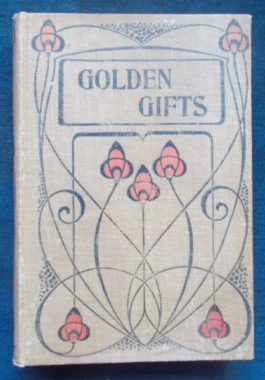 South Australian Matilda Jane Evans, writing under the pseudonym Maud Jeanne Franc, published 14 novels between 1859 and 1885 set in South Australia. These domestic, religious and temperance novels represent a significant contribution of literature to the young colony and demonstrated it was possible to live a worthy spiritual life, dispelling the preconcieved idea that all colonials were necessarily rough and degenerate. Women were represented as being particularly influential in the religious and moral life of the community. The 'Golden Gifts' of the title are their talents and the rich earth of the new country.
South Australian Matilda Jane Evans, writing under the pseudonym Maud Jeanne Franc, published 14 novels between 1859 and 1885 set in South Australia. These domestic, religious and temperance novels represent a significant contribution of literature to the young colony and demonstrated it was possible to live a worthy spiritual life, dispelling the preconcieved idea that all colonials were necessarily rough and degenerate. Women were represented as being particularly influential in the religious and moral life of the community. The 'Golden Gifts' of the title are their talents and the rich earth of the new country. -
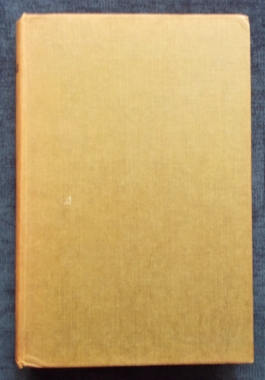

Good Intentions: Ogden Nash
$15.00Nash can't resist a good sly poke at society, pretensions, the battle of the sexes and so much more in this outing of verses, including the Axis powers of World War II - and how not to annoy them! Some of the verse titles...Now Tell Me About Yourself; Pay To The Collector of Internal Revenue; I'll Stay out Of Your Diet If You'll Stay Out Of Mine; I'll Write Their Number Down When We Get Home... From Drive Slow, Man Chortling...Gangway, everybody hold your hats,
Curb your dogs and leash your cats,
Embrace your young in parental clasp,
Breathe in deep and prepare to gasp!
Feel your pulse go rapid and joggly,
Open your eyes and goggle agogly,
Hitch your wonderment to a star -
Here comes me in a brand new car!
-

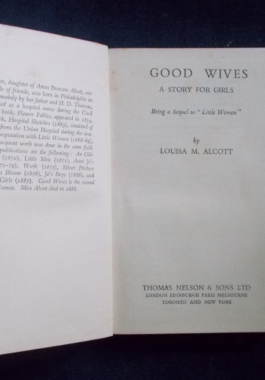 In the sequel to Little Women, the March girls are beginning to grow up and must make their way in the wide world. Meg is determined to marry her John Brooke, despite dire threats of disinheritance from Aunt March; Jo tries her wings, hopping from the family nest to New York to see if she really has the talent to write; Amy is invited to tour Europe with Aunt March and Beth is slowly recuperating from scarlet fever. New experiences come to the girls: Meg is tempted beyond her proud John's means, and must learn some valuable life lessons; Jo escapes Laurie's courtship, falls into the trap of writing sensation stories, knowing that her family would not approve and meets the best friend she will ever have; Amy gets some bewildering lessons in love and Beth has a secret - and not even her family know what that secret is.It is well-known that Alcott based the character of Jo on herself and while Alcott never married, she allowed her alter-ego to have a little romance. A perennial classic.
In the sequel to Little Women, the March girls are beginning to grow up and must make their way in the wide world. Meg is determined to marry her John Brooke, despite dire threats of disinheritance from Aunt March; Jo tries her wings, hopping from the family nest to New York to see if she really has the talent to write; Amy is invited to tour Europe with Aunt March and Beth is slowly recuperating from scarlet fever. New experiences come to the girls: Meg is tempted beyond her proud John's means, and must learn some valuable life lessons; Jo escapes Laurie's courtship, falls into the trap of writing sensation stories, knowing that her family would not approve and meets the best friend she will ever have; Amy gets some bewildering lessons in love and Beth has a secret - and not even her family know what that secret is.It is well-known that Alcott based the character of Jo on herself and while Alcott never married, she allowed her alter-ego to have a little romance. A perennial classic. -
 Mr Chipping, the new teacher at Brookfield School in 1870, finds that he must be a conventional and firm disciplinarian in the classroom to keep the boys in line. This does not make him exactly popular - but his views broaden and his pedagogical manner breaks down after he meets Katherine, a young woman, while he is on holiday. They marry and Katherine charms the Brookfield teachers, the Headmaster and quickly wins the favour of Brookfield's pupils through her kind good humour. She gives her husband the nickname of 'Chips' to the delight of the boys and she teaches Chips how to have a joke with the boys and to close his eyes to some of their minor misdemeanours. Chips' popularity soon rises and his career at Brookfield is very long - but he sees his 'boys' grow to become fine men who can meet the challenges of the sweeping world changes that occur over his long life. A simple, unforgettable and evergreen story that continues to win hearts today.
Mr Chipping, the new teacher at Brookfield School in 1870, finds that he must be a conventional and firm disciplinarian in the classroom to keep the boys in line. This does not make him exactly popular - but his views broaden and his pedagogical manner breaks down after he meets Katherine, a young woman, while he is on holiday. They marry and Katherine charms the Brookfield teachers, the Headmaster and quickly wins the favour of Brookfield's pupils through her kind good humour. She gives her husband the nickname of 'Chips' to the delight of the boys and she teaches Chips how to have a joke with the boys and to close his eyes to some of their minor misdemeanours. Chips' popularity soon rises and his career at Brookfield is very long - but he sees his 'boys' grow to become fine men who can meet the challenges of the sweeping world changes that occur over his long life. A simple, unforgettable and evergreen story that continues to win hearts today. -
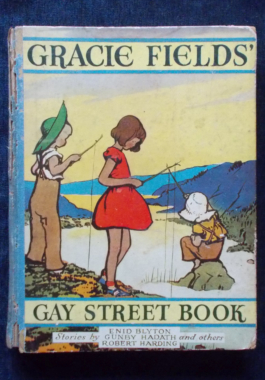 Gracie Fields was well known as a music hall star, singer/comedienne and actress of the 1930s and was voted most popular box office actress in 1937. She was particularly famous for her comedic songs. In this compendium of childrens' stories from the 1950s: Viking Proves Himself, Geoffrey Proust; Good Dog, Tinker! Enid Blyton; Nature Ramble - Spring By Pond And River, Hedgerow Joe; The Saint Piran's Gold, Captain Lawson Smith; The Black Tarn Mystery, Errol Collins; A First-Class Brownie, D.E. Booth; Nature Ramble - Summer To The Sea, Hedgerow Joe; Dreams Go By Contraries, Gunby Hadath; A Piece Of Rope, Edyth Harper; Police Message! T. Holloway; The House Of Candlelight, Robin Rover; Our Dogs, Robert Harding; Nature Ramble - Autumn And Winter, Hedgerow Joe; A Headmaster's Ethics and Channel Conquerors, Robert Harding; In Search Of A Book, Selwyn Gummer. With an introduction by Gracie Fields.
Gracie Fields was well known as a music hall star, singer/comedienne and actress of the 1930s and was voted most popular box office actress in 1937. She was particularly famous for her comedic songs. In this compendium of childrens' stories from the 1950s: Viking Proves Himself, Geoffrey Proust; Good Dog, Tinker! Enid Blyton; Nature Ramble - Spring By Pond And River, Hedgerow Joe; The Saint Piran's Gold, Captain Lawson Smith; The Black Tarn Mystery, Errol Collins; A First-Class Brownie, D.E. Booth; Nature Ramble - Summer To The Sea, Hedgerow Joe; Dreams Go By Contraries, Gunby Hadath; A Piece Of Rope, Edyth Harper; Police Message! T. Holloway; The House Of Candlelight, Robin Rover; Our Dogs, Robert Harding; Nature Ramble - Autumn And Winter, Hedgerow Joe; A Headmaster's Ethics and Channel Conquerors, Robert Harding; In Search Of A Book, Selwyn Gummer. With an introduction by Gracie Fields. -
 The Granny on the Roof-rack...and other tales of modern horror. Over 100 contemporary Australian legends reproduced just as they spread via word-of-mouth, the media, social media and the Internet. The stories range from the funny, to the bizarre and definitely to the terrifying. Told with tongue in cheek and a large grain of salt, topics included in this volume: The Baby In The Microwave; An Elephant On The Mini; The Frozen Chook At The Checkout; Kid(ney) Napping; and of course, the infamous Granny On The Roofrack.
The Granny on the Roof-rack...and other tales of modern horror. Over 100 contemporary Australian legends reproduced just as they spread via word-of-mouth, the media, social media and the Internet. The stories range from the funny, to the bizarre and definitely to the terrifying. Told with tongue in cheek and a large grain of salt, topics included in this volume: The Baby In The Microwave; An Elephant On The Mini; The Frozen Chook At The Checkout; Kid(ney) Napping; and of course, the infamous Granny On The Roofrack. -
 For years they thought it was just them - irritated and tormented by everything around them, from call centres to nose studs, from speed bumps to ringtones. Then along came the television series Grumpy Old Men and they knew they were not alone. It turns out that 35-54 year old men are the grumpiest lot in history. Grumpier than their parents, who were just glad to have survived the war and lived long enough to collect their pensions. Grumpier than their children, who don't care about anything except iPods and tattoos. This book extends the hand of friendship to the young, the old and the women who identified with Grumpy Old Men. It is now a modern movement and its members are proud of the title. Sir Bob Geldof: If you aren't grumpy, that means you're contented with the world. And who the **** could be that? Featuring Rick Stein, Jeremy Clarkson, Arfur Smith, Rick Wakeman and more.
For years they thought it was just them - irritated and tormented by everything around them, from call centres to nose studs, from speed bumps to ringtones. Then along came the television series Grumpy Old Men and they knew they were not alone. It turns out that 35-54 year old men are the grumpiest lot in history. Grumpier than their parents, who were just glad to have survived the war and lived long enough to collect their pensions. Grumpier than their children, who don't care about anything except iPods and tattoos. This book extends the hand of friendship to the young, the old and the women who identified with Grumpy Old Men. It is now a modern movement and its members are proud of the title. Sir Bob Geldof: If you aren't grumpy, that means you're contented with the world. And who the **** could be that? Featuring Rick Stein, Jeremy Clarkson, Arfur Smith, Rick Wakeman and more. -
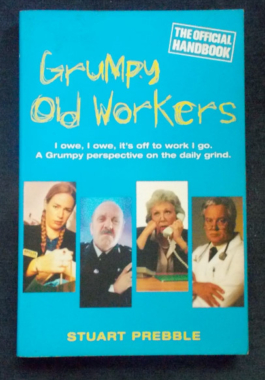 A Grumpy perspective on the daily grind. Whether we are celebrity chef or hapless waiter, engineer or oily rag, commissioning editor or TV producer, all of us have a whole daily wagon-load of s**t to deal with in the name of work. From boardroom to boredom, from 'what's the point?' to PowerPoint, from 9 to 5 to P45. And that's what this book from uber-grump Stuart Prebble is all about; the utter everyday relentless crapulence of working for 'the man', or indeed 'the woman'. It's not possible in a book of this size to include ALL the grumps arising from the working day - the office politics, the shortcomings of IT, the interminable meetings and some of your colleagues' weirder habits, but he is giving it a go. Grumpy? I'll say we are. Illustrated by Noel Ford.
A Grumpy perspective on the daily grind. Whether we are celebrity chef or hapless waiter, engineer or oily rag, commissioning editor or TV producer, all of us have a whole daily wagon-load of s**t to deal with in the name of work. From boardroom to boredom, from 'what's the point?' to PowerPoint, from 9 to 5 to P45. And that's what this book from uber-grump Stuart Prebble is all about; the utter everyday relentless crapulence of working for 'the man', or indeed 'the woman'. It's not possible in a book of this size to include ALL the grumps arising from the working day - the office politics, the shortcomings of IT, the interminable meetings and some of your colleagues' weirder habits, but he is giving it a go. Grumpy? I'll say we are. Illustrated by Noel Ford. -
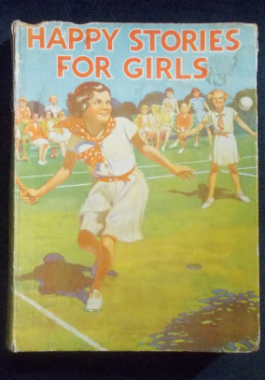 In this volume: Bobbit's Chair, E.E. Cowper; Daphne's Sunset Tiles, Brenda Girvin; Captain Betsy, Dorita Farlie Bruce; The Family Tradition, Shirley Grey; Someday, S.M. Hills; Madge's Burglar, Marjory Royce; Judy And The Treasure, Agnes Frome; Miss Connington, Alice Massie; The Relief Of Fox Lake, C Bernard Rutley. Colour plates and line drawing illustrations.
In this volume: Bobbit's Chair, E.E. Cowper; Daphne's Sunset Tiles, Brenda Girvin; Captain Betsy, Dorita Farlie Bruce; The Family Tradition, Shirley Grey; Someday, S.M. Hills; Madge's Burglar, Marjory Royce; Judy And The Treasure, Agnes Frome; Miss Connington, Alice Massie; The Relief Of Fox Lake, C Bernard Rutley. Colour plates and line drawing illustrations. -

Hardy’s People: Frank Hardy
$15.00Truthful Jones is the teller of the world's tallest tales - how to beat parking officers, the four-legged lottery, crime, politics and death. He tells behind-the-scenes stories about the government of Nifty Neville Wran, Bob Hawke, Menzies and Fraser; why attendances are falling at Aussie Rules matches and the inside story on cricket 'sledging'. Want to back the Melbourne Cup winner with the perfect system? Truthful has the tips. A selection of the best from Hardy's column in People magazine. -
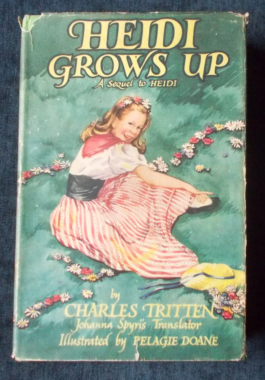 The last chapter of Heidi was called, 'Promises to Meet Again.' In this sequel, written by Johanna Spyri's translator, all the timeless characters do meet again - Peter, the goat-herd; Clara, no longer an invalid; Granny; the good Doctor and Grandfather. There are new characters to meet and new stories to tell as Heidi begins a strange new life at boarding school. Illustrations by Pelagie Doane.
The last chapter of Heidi was called, 'Promises to Meet Again.' In this sequel, written by Johanna Spyri's translator, all the timeless characters do meet again - Peter, the goat-herd; Clara, no longer an invalid; Granny; the good Doctor and Grandfather. There are new characters to meet and new stories to tell as Heidi begins a strange new life at boarding school. Illustrations by Pelagie Doane. -

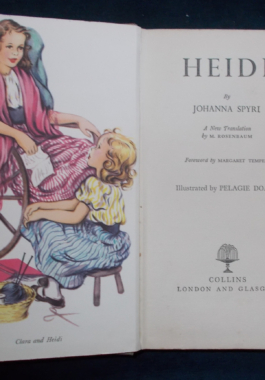
Heidi: Johanna Spyri
$9.00First published in 1880, here is Heidi's story - a young Swiss girl whose parents' sudden death leaves her to be brought up by her Aunt Dete - a hard-working woman who loves Heidi, but does not have the time or resources to look after a child in busy Frankfurt. She leaves Heidi with Heidi's grandfather, who lives in the Swiss mountains. The lonely, embittered old man lives like a hermit on the mountain-top and has nothing to do with the people in the village below. Known to all as “Alm-uncle”, Heidi's grandfather is good-hearted but mistrustful of the villagers. He refuses to send Heidi to school and allows her to roam the pastures with a mischeivous young goat herder, Peter. They become good friends but events take a turn when Aunt Dete decides that Heidi must stay in Frankfurt and learn to earn a living as a companion to a rich invalid child, Clara, and soon learns to read and write along with the little girl. The city begins to take its toll on the young Heidi and she becomes ill and depressed, longing for the open spaces. How Heidi returns to her beloved mountains, reforms her crotchety old grandfather and helps Clara regain her health forms the rest of this perennial classic. With illustrations in colour and black and white by Pelagie Doane. -
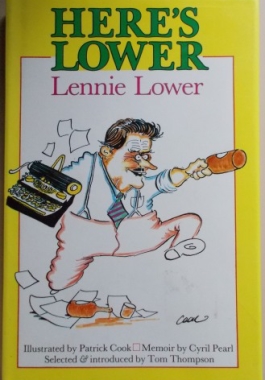
Here’s Lower: Lennie Lower
$20.00Lower only wrote the one novel, Here's Luck, in which Gudgeon and Son battle the great Australian icons - the police, the wife, the booze and the races. Here is a selection of his whimsical newspaper columns of the 1930s, short tales which were a showcase for Lower's natural Aussie anarchy. You can get the low-down on Banking; The Cruel Tactics of the Emu; The Terrors of Wealth; The Perils of the Bathtub and What Bread Is and How To Use It among other wits and wisdoms on life. -
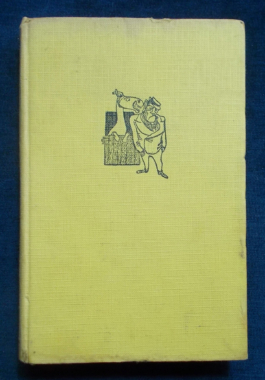

Here’s Luck: Lennie Lower
$25.00Lower's iconic novel which took its place in Australian culture, never to be dislodged. Rather like its main character, Jack Gudgeon. Residing in a run-down Sydney suburb during the Depression is Gudgeon - 48, a male chauvinist, an in-debt cynic, layabout and barroom philosopher. His wife, Agatha, having had more than she can take, has finally walked out on him. With Jack - and his equally unreliable adolescent son Stanley - fending for themselves, pandemonium ensues. Full of sardonic Aussie wit and mad capers, father and son blaze a trail of drunken chaos through the city's pubs, clubs, race courses, and their own increasingly battered home. Along the way, they fall in with a wondrous assortment of dubious characters who turn up to enliven the kind of party that Mr. Gudgeon invariably intends to be a "quiet, respectable turnout," but which, somehow, never is. Illustrated by the equally classic cartoonist 'Wep'. -
 In 1973, ABC Radio broadcast a series of radio talks - Heresies. The series featured provocative and often unorthodox views of social, political economic and cultural issues, often challenging established opinion. It was intended as a medium for ideas, rather than a forum for prominent public figures. Featured in this collection: Professor Frederick May: The Revival of the Cliche and Frolic of Painted Dolls; Rev. Norman Webb: The End of History and Man has Come Of Age; Beatrice Faust: Sex - Common Sense or Popular Fallacy and Nice Girls Do; Helen Palmer: If You Can't Measure It, It Doesn't Exist and many more.
In 1973, ABC Radio broadcast a series of radio talks - Heresies. The series featured provocative and often unorthodox views of social, political economic and cultural issues, often challenging established opinion. It was intended as a medium for ideas, rather than a forum for prominent public figures. Featured in this collection: Professor Frederick May: The Revival of the Cliche and Frolic of Painted Dolls; Rev. Norman Webb: The End of History and Man has Come Of Age; Beatrice Faust: Sex - Common Sense or Popular Fallacy and Nice Girls Do; Helen Palmer: If You Can't Measure It, It Doesn't Exist and many more. -

 A very thorough work which - in this edition - also covers the years since Federation. Contents: The First Visitors; The Penal Settlement; The Colony Expands; The Days of Bourke; The Daughter Colonies; The Coming Of Self-Government; New Zealand In The Early Days; New Zealand 139-1851; The Gold Discoveries And Their Results; Filling In The Map; Constitutional Government; New Zealand Since 1850; Australiasia; Australian Literature: this chapter covers such luminaries as Henry Kendall, Marcus Clarke; A.B. 'Banjo' Paterson, Henry Lawson and Adam Lindsay Gordon, among others. A must for any sincere history buff. With fine colour maps, numerous black and white illustrations and useful margin notations for quick reference.
A very thorough work which - in this edition - also covers the years since Federation. Contents: The First Visitors; The Penal Settlement; The Colony Expands; The Days of Bourke; The Daughter Colonies; The Coming Of Self-Government; New Zealand In The Early Days; New Zealand 139-1851; The Gold Discoveries And Their Results; Filling In The Map; Constitutional Government; New Zealand Since 1850; Australiasia; Australian Literature: this chapter covers such luminaries as Henry Kendall, Marcus Clarke; A.B. 'Banjo' Paterson, Henry Lawson and Adam Lindsay Gordon, among others. A must for any sincere history buff. With fine colour maps, numerous black and white illustrations and useful margin notations for quick reference. -
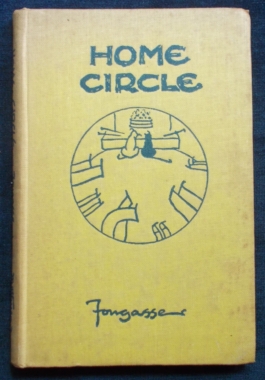
Home Circle: Fougasse
$15.00A wonderful little book of cartoons on the joys of everyday life in wartime, with some good sly social comments on the little human pomposities of the time.


